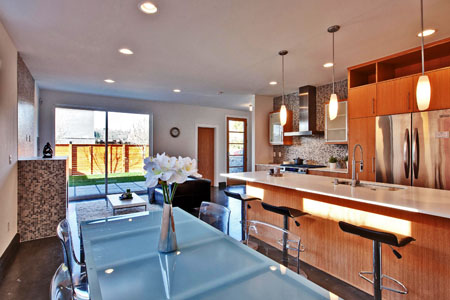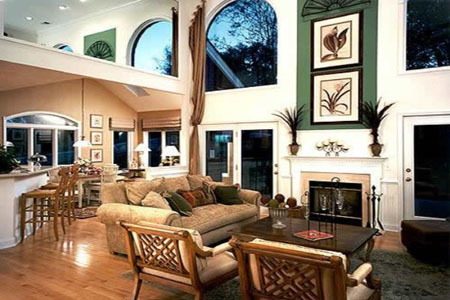Inside the New American Home
 While housing, and homebuilding in particular, have taken a massive hit due to the Great Recession, many housing experts do not expect this trend to continue long term as more unemployed Americans get back to work, empty-nesters begin to downsize or build their dream homes, and 'boomerang kids' who were “doubling-up,” or living with their extended family, decide to move out of Mom and Dad’s basement and strike out on their own.
While housing, and homebuilding in particular, have taken a massive hit due to the Great Recession, many housing experts do not expect this trend to continue long term as more unemployed Americans get back to work, empty-nesters begin to downsize or build their dream homes, and 'boomerang kids' who were “doubling-up,” or living with their extended family, decide to move out of Mom and Dad’s basement and strike out on their own.According to the National Association of Home Builders, this “pent-up demand” for new homes is expected to increase only slightly in the coming months, but the new homes to enter the market will be tailor-made to fit Americans’ changing needs and desires in the post-recession years.(Experts say the New American Home is small but smartly designed.Photo: Dan Sandoval)
“What’s driving it all is affordability,” says John McIlwain, senior fellow for housing at the Urban Land Institute in Washington, D.C., who notes that high unemployment, credit and student loan debt, stricter mortgage rules and a surplus of foreclosed homes will likely continue to scare many first-time buyers from the housing market and keep new home construction relatively slow.
The McMansion home of pre-recession years is on the way out, but a quality home with “well-designed bones” that is relatively inexpensive to operate has become more desirable, says McIlwain.
MainStreet talked to homebuilding experts to learn more about some of the key features home shoppers can expect to find in the new American home this year. Read on to learn all about the modern-day dream home and what not to expect on your house-hunting adventures.
Utility & Value
Homebuilders will continue to scale back on luxury add-ons, which are becoming more of an afterthought, says McIlwain, as homebuyers opt for a more modest and functional home, rather than a McMansion with a Jacuzzi and a heated pool.
“People are looking for shelter and value,” says Stephen Mellman, director of economic services for the National Association of Home Builders in Washington, D.C. “Everyone has their own lifestyle and they want to find a home to enhance their lifestyle and make it more efficient.”
Also with affordability still a huge factor for homebuyers, buying a new home no longer entails “doing fancy things” just for the sake of making a boom era statement, nor does it mean sinking the greater chunk of your cash into a long-term investment, as “the likelihood that that house value will appreciate is extraordinarily remote,” notes McIlwain.
The most noteworthy trend this year is that homebuyers are beginning to see their home as an extension of their lifestyle, whether that means making a strategic move from the suburbs for a shorter commute, having more proximity to downtown hotspots or finding a way to downsize after the children have flown the coop.
“This is shelter,” Mellman agrees, “it isn’t just an investment to sell in a year; you’re going to live here and raise your kids here and that colors everything: how you design it and what you’ll enjoy."
Fuss-Free Kitchens
 Whether your lifestyle is fast-paced or decidedly more conservative, Americans are spending more time in the kitchen and less in the formal dining room, which is starting to disappear. The reasons behind this shift vary from more Americans deciding to cook their own dinner to save on the costs of eating out or our increasing dependence on a usable kitchen that can entertain family and friends. As a result, spacious, eat-in kitchens that open up to the common room are now a huge trend for homebuilders in 2011, and the dining room, once its own separate space, is now simply designated by a table and chandelier, as people “try to do more with less,” says Mellman.(Eating meals with a view of the kitchen is considered 'in'.Photo: Zillow)
Whether your lifestyle is fast-paced or decidedly more conservative, Americans are spending more time in the kitchen and less in the formal dining room, which is starting to disappear. The reasons behind this shift vary from more Americans deciding to cook their own dinner to save on the costs of eating out or our increasing dependence on a usable kitchen that can entertain family and friends. As a result, spacious, eat-in kitchens that open up to the common room are now a huge trend for homebuilders in 2011, and the dining room, once its own separate space, is now simply designated by a table and chandelier, as people “try to do more with less,” says Mellman.(Eating meals with a view of the kitchen is considered 'in'.Photo: Zillow)“You want an open kitchen because when you’re doing the cooking and entertaining, everybody gathers in the kitchen,” McIlwain says, noting Americans’ casual lifestyle and our ongoing obsession with food. “You don’t have a maid in the kitchen, but [when you’re cooking] you want to be part of the action. Cooking has become part of the whole entertainment process. And for couples, cooking together is a team sport, rather than an individual sport.”
But despite being the center of attention, the new American home’s kitchen doesn’t look quite as glamorous as it used to.
“The gourmet kitchen is on the way out,” says Mellman. “You don’t need eight burners” or a Vulcan stove, Mellman says. Americans post-recession are focused on standard appliances that they know they will use every day.
“A great stove, a fridge with an ice-maker and water filters, two sinks, a quiet wash dishwasher, or the equivalent—it doesn’t have to be commercial kitchen grade, but a decent quality kitchen that’s easy to move around in, and therefore cook in, with plenty of counter space and that’s easy to hang out in” is where the homebuilding trend is going, McIlwain says.
To save on kitchen construction costs, Dan Sandoval, a homebuilder with Republic Homebuilders in Fredericksburg, Va., says homebuyers are also forgoing traditionally pricey granite countertops for standard laminate countertops.
“Five years ago, they wouldn’t have sold, but now they’re OK,” he says of the materials. “It’s nice-looking, but very affordable,” unlike the dining room, which buyers now consider “wasted space” and an unattractive feature, says Sandoval.
“What I hear from customers is that they just don’t use it,” he says. “They don’t eat in there every Sunday, like their parents used to do. That’s not their lifestyle.”
Smaller Square Footage
It isn’t your imagination—the new American homes are actually getting smaller, according to a National Association of Home Builders’ report, The New Home in 2015.
In it, the NAHB found that the average size of single-family homes completed in 2009 dropped to 2,438 square feet, and in the first half of 2010, the average size of new homes completed continued its slide, dropping to 2,378 square feet.
 What’s more, according to the NAHB study, bedrooms and baths have also downsized as well, as the share of single-family homes with four bedrooms or more has declined for three consecutive years, from 39% in 2005 and 2006 to 35% in the first half of 2010, and most new homes completed in 2008 and 2009 had either 2 or 2.5 baths (68%).(The Great Room living space resonates more than ever.Photo: Zillow)
What’s more, according to the NAHB study, bedrooms and baths have also downsized as well, as the share of single-family homes with four bedrooms or more has declined for three consecutive years, from 39% in 2005 and 2006 to 35% in the first half of 2010, and most new homes completed in 2008 and 2009 had either 2 or 2.5 baths (68%).(The Great Room living space resonates more than ever.Photo: Zillow)So what’s the story behind all these shrinking homes? “New homes that are being built by and large are tending to be smaller because that makes them more affordable,” explains McIlwain, who adds that “even the very wealthy will buy a home much smaller than they could afford,” just to cut back on living costs or perhaps to funnel their money into retirement savings and other mid-life goals.
As a result, certain rooms, like the formal dining room and traditional living room, are becoming extinct species or taking new forms in the combination spaces that are beginning to crop up, such as the eat-in kitchen and dining area, or the second or third bedroom, which has begun to do double-duty as a home office, McIlwain says. “Whether they’re working at home or having a room to keep personal information, such as taxes, an in-home office is more to take care of personal matters,” adds Sandoval.
Meanwhile, Mellman says stairways are moving from their traditional post in the front of the house, or entrance/foyer, to the back and the side, in yet another effort by homebuilders to curtail construction costs and provide more room.
Energy-Efficient Materials
EnergyStar homes have become the gold standard, but homebuyers remain hesitant to splurge on solar roofs or eco-friendly siding, says Mellman.
“Some of my customers inquire about those systems, but they don’t see the return on it,” Sandoval explains about pricey green add-ons. “It’s too costly at this time. Unfortunately, a lot of our customers have lost a lot of their retirement in the stock market, and they’re just trying to get a basic house to last them in their retirement. They would love to have those sorts of things, but they have to think of the costs.”
Tax breaks also play a role, and the lack of them in Virginia makes them even less appealing for prospective homebuyers, says Sandoval. Adds Mellman: “People want to have a green home and incorporate those features, but to a certain extent they’re not going to stretch themselves to get those things. Also, appraisers weren’t including those things for awhile, so a home would sell for less than its actual value and the cost of construction.”
Still, energy-efficiency has become a mainstay for empty-nesters looking to cut down the costs of heating and cooling a home, while other amenities, like EnergyStar windows, are becoming more commonplace and widely embraced.
“Green is no longer an amenity,” says McIlwain. “EnergyStar, EnergyStar windows, very efficient HVAC systems, siding to take advantage of solar power—those are the homes that are selling and they’re becoming the standard. They’re materials you’ve got be attuned to.”
Apr 29, 2011